Dissertation: Parents' Experiences of Long-Term Child Hospitalization
VerifiedAdded on 2020/10/05
|29
|8713
|500
Project
AI Summary
This dissertation explores the experiences of parents whose children have undergone long-term hospitalizations. The research begins with an introduction that defines key terms, provides statistics on the incidence and prevalence of child hospital stays, and outlines relevant policies and guidance. It then reviews existing literature, establishes the rationale for the research, and formulates the research question and objectives. The methodology chapter details the search strategy, including the use of the PICO framework, database selection (CINAHL and Medline), and inclusion/exclusion criteria. It also discusses critical evaluation methods. The findings chapter presents study characteristics, an article summary table, the identification of themes, and a summary of the results. The discussion chapter analyzes the identified themes, provides recommendations for research, practice, and education, and reviews the limitations of the study. The dissertation concludes with a summary of findings and a list of references. The appendix includes the CASP Qualitative Appraisal Tool.

RESEARCH
DISSERTATION
DISSERTATION
Paraphrase This Document
Need a fresh take? Get an instant paraphrase of this document with our AI Paraphraser
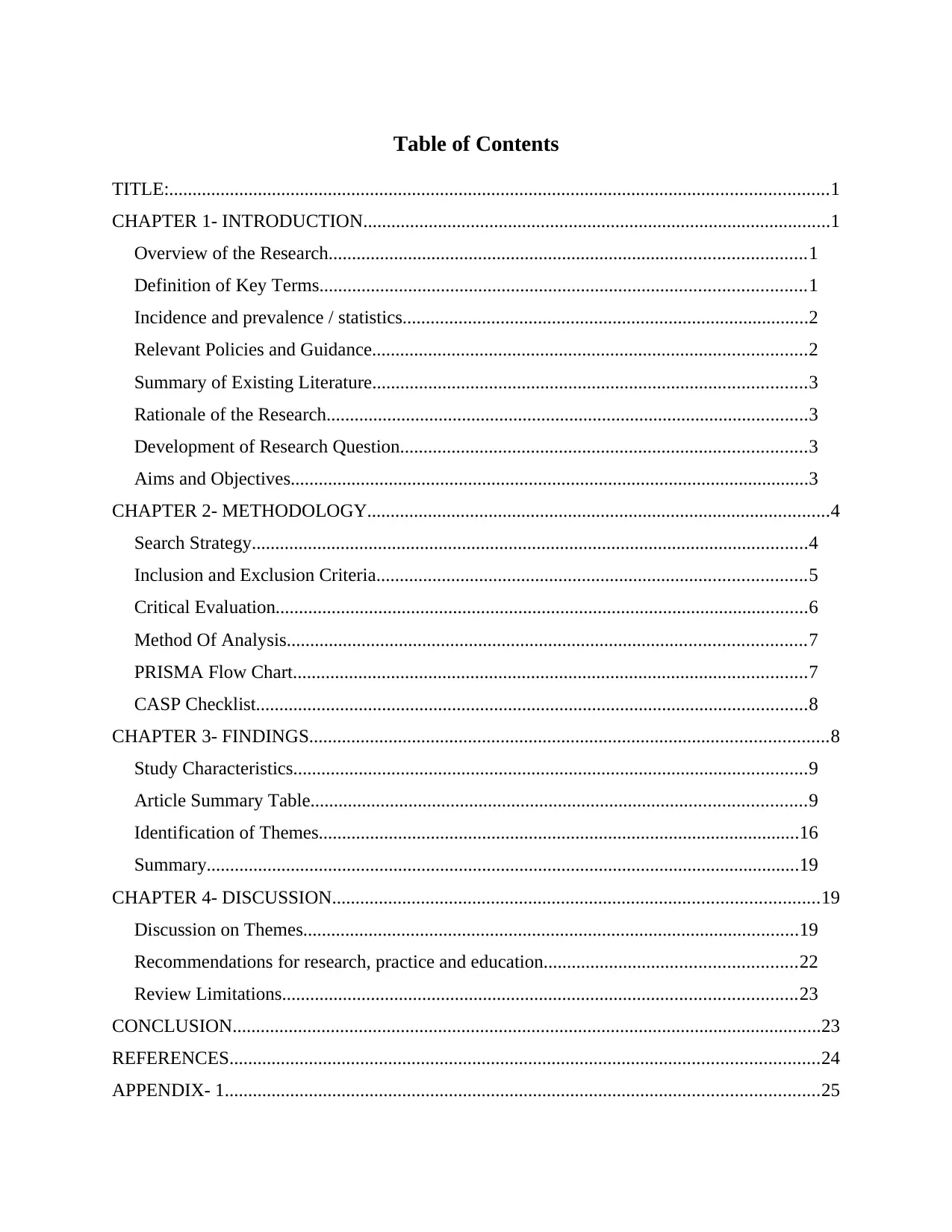
Table of Contents
TITLE:.............................................................................................................................................1
CHAPTER 1- INTRODUCTION....................................................................................................1
Overview of the Research......................................................................................................1
Definition of Key Terms........................................................................................................1
Incidence and prevalence / statistics.......................................................................................2
Relevant Policies and Guidance.............................................................................................2
Summary of Existing Literature.............................................................................................3
Rationale of the Research.......................................................................................................3
Development of Research Question.......................................................................................3
Aims and Objectives...............................................................................................................3
CHAPTER 2- METHODOLOGY...................................................................................................4
Search Strategy.......................................................................................................................4
Inclusion and Exclusion Criteria............................................................................................5
Critical Evaluation..................................................................................................................6
Method Of Analysis...............................................................................................................7
PRISMA Flow Chart..............................................................................................................7
CASP Checklist......................................................................................................................8
CHAPTER 3- FINDINGS...............................................................................................................8
Study Characteristics..............................................................................................................9
Article Summary Table..........................................................................................................9
Identification of Themes.......................................................................................................16
Summary...............................................................................................................................19
CHAPTER 4- DISCUSSION........................................................................................................19
Discussion on Themes..........................................................................................................19
Recommendations for research, practice and education......................................................22
Review Limitations..............................................................................................................23
CONCLUSION..............................................................................................................................23
REFERENCES..............................................................................................................................24
APPENDIX- 1...............................................................................................................................25
TITLE:.............................................................................................................................................1
CHAPTER 1- INTRODUCTION....................................................................................................1
Overview of the Research......................................................................................................1
Definition of Key Terms........................................................................................................1
Incidence and prevalence / statistics.......................................................................................2
Relevant Policies and Guidance.............................................................................................2
Summary of Existing Literature.............................................................................................3
Rationale of the Research.......................................................................................................3
Development of Research Question.......................................................................................3
Aims and Objectives...............................................................................................................3
CHAPTER 2- METHODOLOGY...................................................................................................4
Search Strategy.......................................................................................................................4
Inclusion and Exclusion Criteria............................................................................................5
Critical Evaluation..................................................................................................................6
Method Of Analysis...............................................................................................................7
PRISMA Flow Chart..............................................................................................................7
CASP Checklist......................................................................................................................8
CHAPTER 3- FINDINGS...............................................................................................................8
Study Characteristics..............................................................................................................9
Article Summary Table..........................................................................................................9
Identification of Themes.......................................................................................................16
Summary...............................................................................................................................19
CHAPTER 4- DISCUSSION........................................................................................................19
Discussion on Themes..........................................................................................................19
Recommendations for research, practice and education......................................................22
Review Limitations..............................................................................................................23
CONCLUSION..............................................................................................................................23
REFERENCES..............................................................................................................................24
APPENDIX- 1...............................................................................................................................25

CASP Qualitative Appraisal Tool........................................................................................25
⊘ This is a preview!⊘
Do you want full access?
Subscribe today to unlock all pages.

Trusted by 1+ million students worldwide
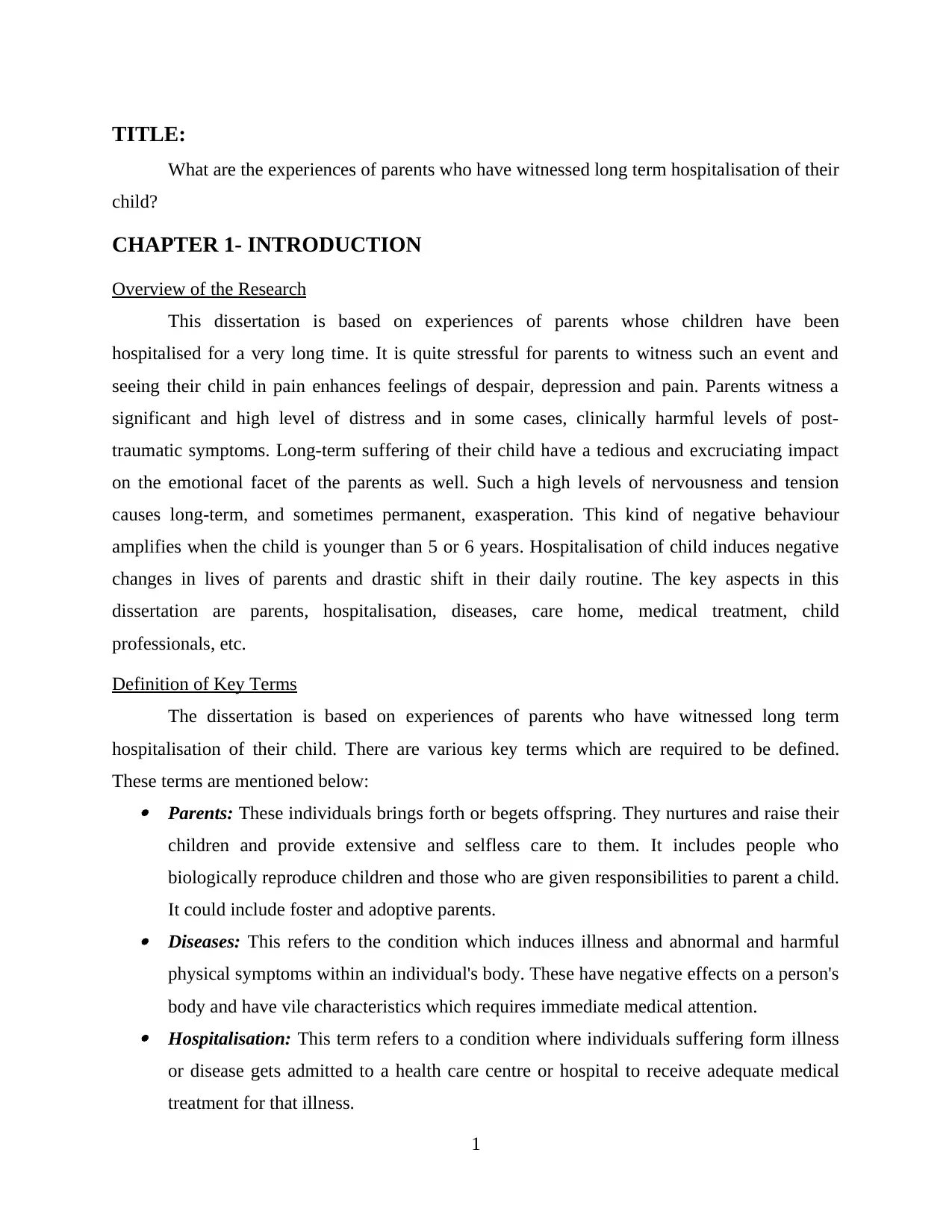
TITLE:
What are the experiences of parents who have witnessed long term hospitalisation of their
child?
CHAPTER 1- INTRODUCTION
Overview of the Research
This dissertation is based on experiences of parents whose children have been
hospitalised for a very long time. It is quite stressful for parents to witness such an event and
seeing their child in pain enhances feelings of despair, depression and pain. Parents witness a
significant and high level of distress and in some cases, clinically harmful levels of post-
traumatic symptoms. Long-term suffering of their child have a tedious and excruciating impact
on the emotional facet of the parents as well. Such a high levels of nervousness and tension
causes long-term, and sometimes permanent, exasperation. This kind of negative behaviour
amplifies when the child is younger than 5 or 6 years. Hospitalisation of child induces negative
changes in lives of parents and drastic shift in their daily routine. The key aspects in this
dissertation are parents, hospitalisation, diseases, care home, medical treatment, child
professionals, etc.
Definition of Key Terms
The dissertation is based on experiences of parents who have witnessed long term
hospitalisation of their child. There are various key terms which are required to be defined.
These terms are mentioned below: Parents: These individuals brings forth or begets offspring. They nurtures and raise their
children and provide extensive and selfless care to them. It includes people who
biologically reproduce children and those who are given responsibilities to parent a child.
It could include foster and adoptive parents. Diseases: This refers to the condition which induces illness and abnormal and harmful
physical symptoms within an individual's body. These have negative effects on a person's
body and have vile characteristics which requires immediate medical attention. Hospitalisation: This term refers to a condition where individuals suffering form illness
or disease gets admitted to a health care centre or hospital to receive adequate medical
treatment for that illness.
1
What are the experiences of parents who have witnessed long term hospitalisation of their
child?
CHAPTER 1- INTRODUCTION
Overview of the Research
This dissertation is based on experiences of parents whose children have been
hospitalised for a very long time. It is quite stressful for parents to witness such an event and
seeing their child in pain enhances feelings of despair, depression and pain. Parents witness a
significant and high level of distress and in some cases, clinically harmful levels of post-
traumatic symptoms. Long-term suffering of their child have a tedious and excruciating impact
on the emotional facet of the parents as well. Such a high levels of nervousness and tension
causes long-term, and sometimes permanent, exasperation. This kind of negative behaviour
amplifies when the child is younger than 5 or 6 years. Hospitalisation of child induces negative
changes in lives of parents and drastic shift in their daily routine. The key aspects in this
dissertation are parents, hospitalisation, diseases, care home, medical treatment, child
professionals, etc.
Definition of Key Terms
The dissertation is based on experiences of parents who have witnessed long term
hospitalisation of their child. There are various key terms which are required to be defined.
These terms are mentioned below: Parents: These individuals brings forth or begets offspring. They nurtures and raise their
children and provide extensive and selfless care to them. It includes people who
biologically reproduce children and those who are given responsibilities to parent a child.
It could include foster and adoptive parents. Diseases: This refers to the condition which induces illness and abnormal and harmful
physical symptoms within an individual's body. These have negative effects on a person's
body and have vile characteristics which requires immediate medical attention. Hospitalisation: This term refers to a condition where individuals suffering form illness
or disease gets admitted to a health care centre or hospital to receive adequate medical
treatment for that illness.
1
Paraphrase This Document
Need a fresh take? Get an instant paraphrase of this document with our AI Paraphraser
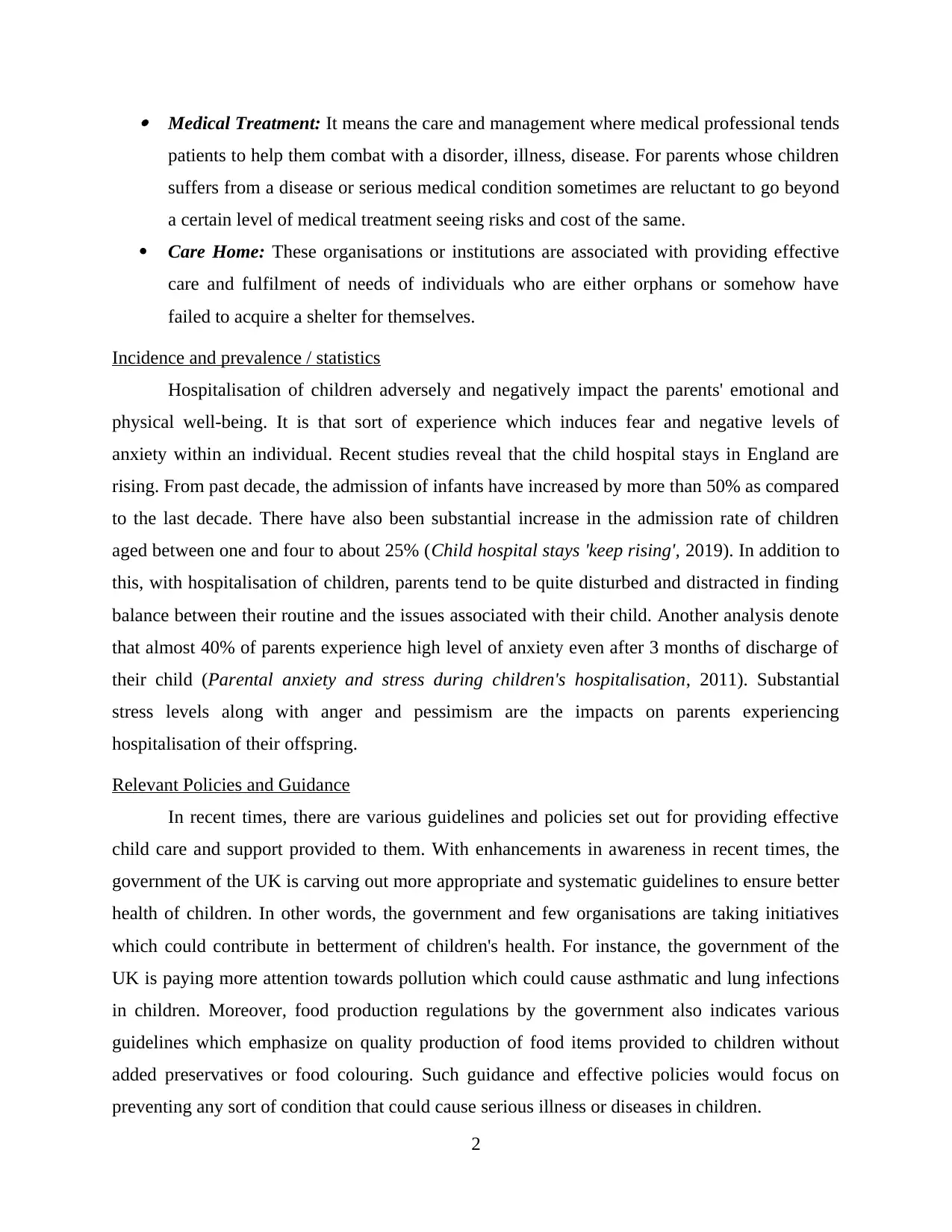
Medical Treatment: It means the care and management where medical professional tends
patients to help them combat with a disorder, illness, disease. For parents whose children
suffers from a disease or serious medical condition sometimes are reluctant to go beyond
a certain level of medical treatment seeing risks and cost of the same.
Care Home: These organisations or institutions are associated with providing effective
care and fulfilment of needs of individuals who are either orphans or somehow have
failed to acquire a shelter for themselves.
Incidence and prevalence / statistics
Hospitalisation of children adversely and negatively impact the parents' emotional and
physical well-being. It is that sort of experience which induces fear and negative levels of
anxiety within an individual. Recent studies reveal that the child hospital stays in England are
rising. From past decade, the admission of infants have increased by more than 50% as compared
to the last decade. There have also been substantial increase in the admission rate of children
aged between one and four to about 25% (Child hospital stays 'keep rising', 2019). In addition to
this, with hospitalisation of children, parents tend to be quite disturbed and distracted in finding
balance between their routine and the issues associated with their child. Another analysis denote
that almost 40% of parents experience high level of anxiety even after 3 months of discharge of
their child (Parental anxiety and stress during children's hospitalisation, 2011). Substantial
stress levels along with anger and pessimism are the impacts on parents experiencing
hospitalisation of their offspring.
Relevant Policies and Guidance
In recent times, there are various guidelines and policies set out for providing effective
child care and support provided to them. With enhancements in awareness in recent times, the
government of the UK is carving out more appropriate and systematic guidelines to ensure better
health of children. In other words, the government and few organisations are taking initiatives
which could contribute in betterment of children's health. For instance, the government of the
UK is paying more attention towards pollution which could cause asthmatic and lung infections
in children. Moreover, food production regulations by the government also indicates various
guidelines which emphasize on quality production of food items provided to children without
added preservatives or food colouring. Such guidance and effective policies would focus on
preventing any sort of condition that could cause serious illness or diseases in children.
2
patients to help them combat with a disorder, illness, disease. For parents whose children
suffers from a disease or serious medical condition sometimes are reluctant to go beyond
a certain level of medical treatment seeing risks and cost of the same.
Care Home: These organisations or institutions are associated with providing effective
care and fulfilment of needs of individuals who are either orphans or somehow have
failed to acquire a shelter for themselves.
Incidence and prevalence / statistics
Hospitalisation of children adversely and negatively impact the parents' emotional and
physical well-being. It is that sort of experience which induces fear and negative levels of
anxiety within an individual. Recent studies reveal that the child hospital stays in England are
rising. From past decade, the admission of infants have increased by more than 50% as compared
to the last decade. There have also been substantial increase in the admission rate of children
aged between one and four to about 25% (Child hospital stays 'keep rising', 2019). In addition to
this, with hospitalisation of children, parents tend to be quite disturbed and distracted in finding
balance between their routine and the issues associated with their child. Another analysis denote
that almost 40% of parents experience high level of anxiety even after 3 months of discharge of
their child (Parental anxiety and stress during children's hospitalisation, 2011). Substantial
stress levels along with anger and pessimism are the impacts on parents experiencing
hospitalisation of their offspring.
Relevant Policies and Guidance
In recent times, there are various guidelines and policies set out for providing effective
child care and support provided to them. With enhancements in awareness in recent times, the
government of the UK is carving out more appropriate and systematic guidelines to ensure better
health of children. In other words, the government and few organisations are taking initiatives
which could contribute in betterment of children's health. For instance, the government of the
UK is paying more attention towards pollution which could cause asthmatic and lung infections
in children. Moreover, food production regulations by the government also indicates various
guidelines which emphasize on quality production of food items provided to children without
added preservatives or food colouring. Such guidance and effective policies would focus on
preventing any sort of condition that could cause serious illness or diseases in children.
2
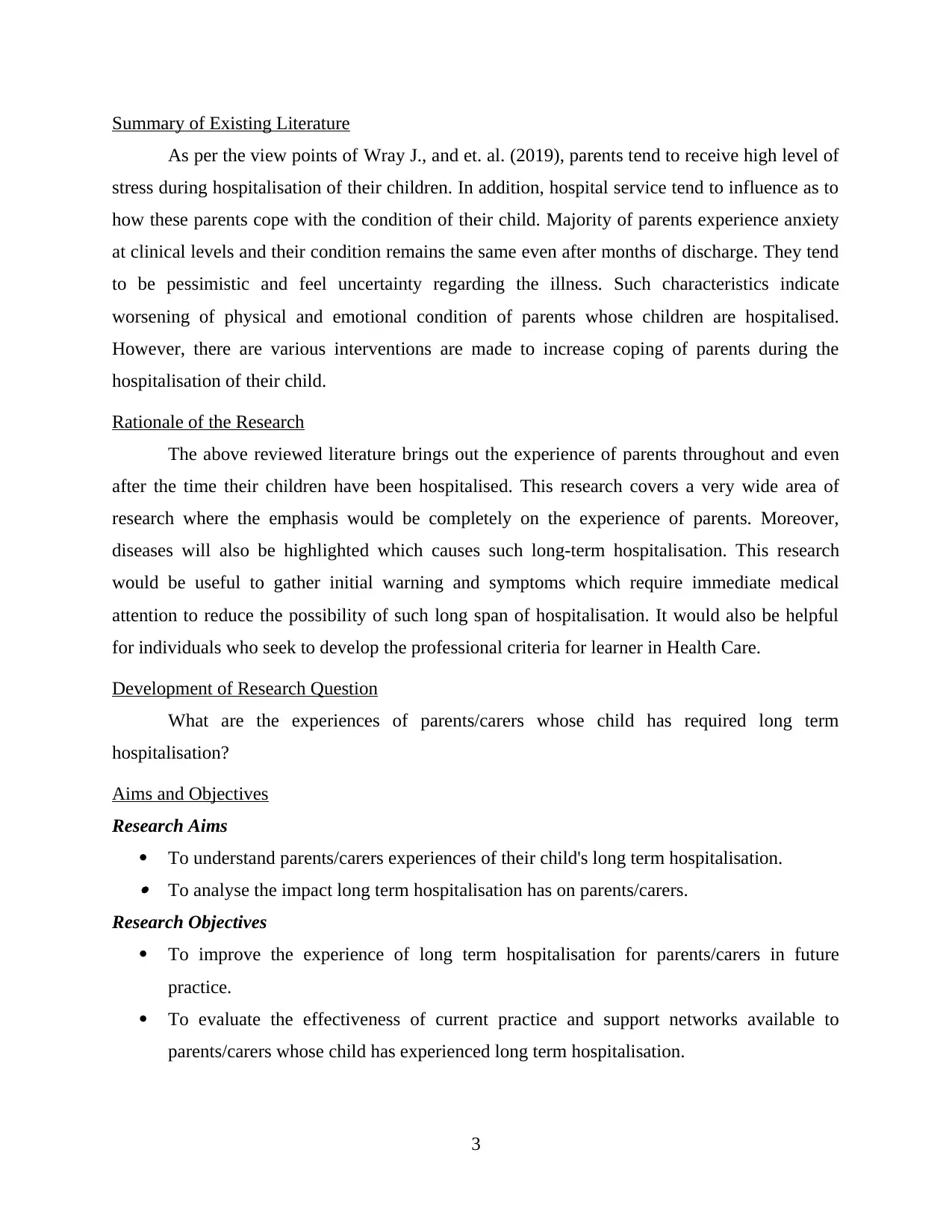
Summary of Existing Literature
As per the view points of Wray J., and et. al. (2019), parents tend to receive high level of
stress during hospitalisation of their children. In addition, hospital service tend to influence as to
how these parents cope with the condition of their child. Majority of parents experience anxiety
at clinical levels and their condition remains the same even after months of discharge. They tend
to be pessimistic and feel uncertainty regarding the illness. Such characteristics indicate
worsening of physical and emotional condition of parents whose children are hospitalised.
However, there are various interventions are made to increase coping of parents during the
hospitalisation of their child.
Rationale of the Research
The above reviewed literature brings out the experience of parents throughout and even
after the time their children have been hospitalised. This research covers a very wide area of
research where the emphasis would be completely on the experience of parents. Moreover,
diseases will also be highlighted which causes such long-term hospitalisation. This research
would be useful to gather initial warning and symptoms which require immediate medical
attention to reduce the possibility of such long span of hospitalisation. It would also be helpful
for individuals who seek to develop the professional criteria for learner in Health Care.
Development of Research Question
What are the experiences of parents/carers whose child has required long term
hospitalisation?
Aims and Objectives
Research Aims
To understand parents/carers experiences of their child's long term hospitalisation. To analyse the impact long term hospitalisation has on parents/carers.
Research Objectives
To improve the experience of long term hospitalisation for parents/carers in future
practice.
To evaluate the effectiveness of current practice and support networks available to
parents/carers whose child has experienced long term hospitalisation.
3
As per the view points of Wray J., and et. al. (2019), parents tend to receive high level of
stress during hospitalisation of their children. In addition, hospital service tend to influence as to
how these parents cope with the condition of their child. Majority of parents experience anxiety
at clinical levels and their condition remains the same even after months of discharge. They tend
to be pessimistic and feel uncertainty regarding the illness. Such characteristics indicate
worsening of physical and emotional condition of parents whose children are hospitalised.
However, there are various interventions are made to increase coping of parents during the
hospitalisation of their child.
Rationale of the Research
The above reviewed literature brings out the experience of parents throughout and even
after the time their children have been hospitalised. This research covers a very wide area of
research where the emphasis would be completely on the experience of parents. Moreover,
diseases will also be highlighted which causes such long-term hospitalisation. This research
would be useful to gather initial warning and symptoms which require immediate medical
attention to reduce the possibility of such long span of hospitalisation. It would also be helpful
for individuals who seek to develop the professional criteria for learner in Health Care.
Development of Research Question
What are the experiences of parents/carers whose child has required long term
hospitalisation?
Aims and Objectives
Research Aims
To understand parents/carers experiences of their child's long term hospitalisation. To analyse the impact long term hospitalisation has on parents/carers.
Research Objectives
To improve the experience of long term hospitalisation for parents/carers in future
practice.
To evaluate the effectiveness of current practice and support networks available to
parents/carers whose child has experienced long term hospitalisation.
3
⊘ This is a preview!⊘
Do you want full access?
Subscribe today to unlock all pages.

Trusted by 1+ million students worldwide
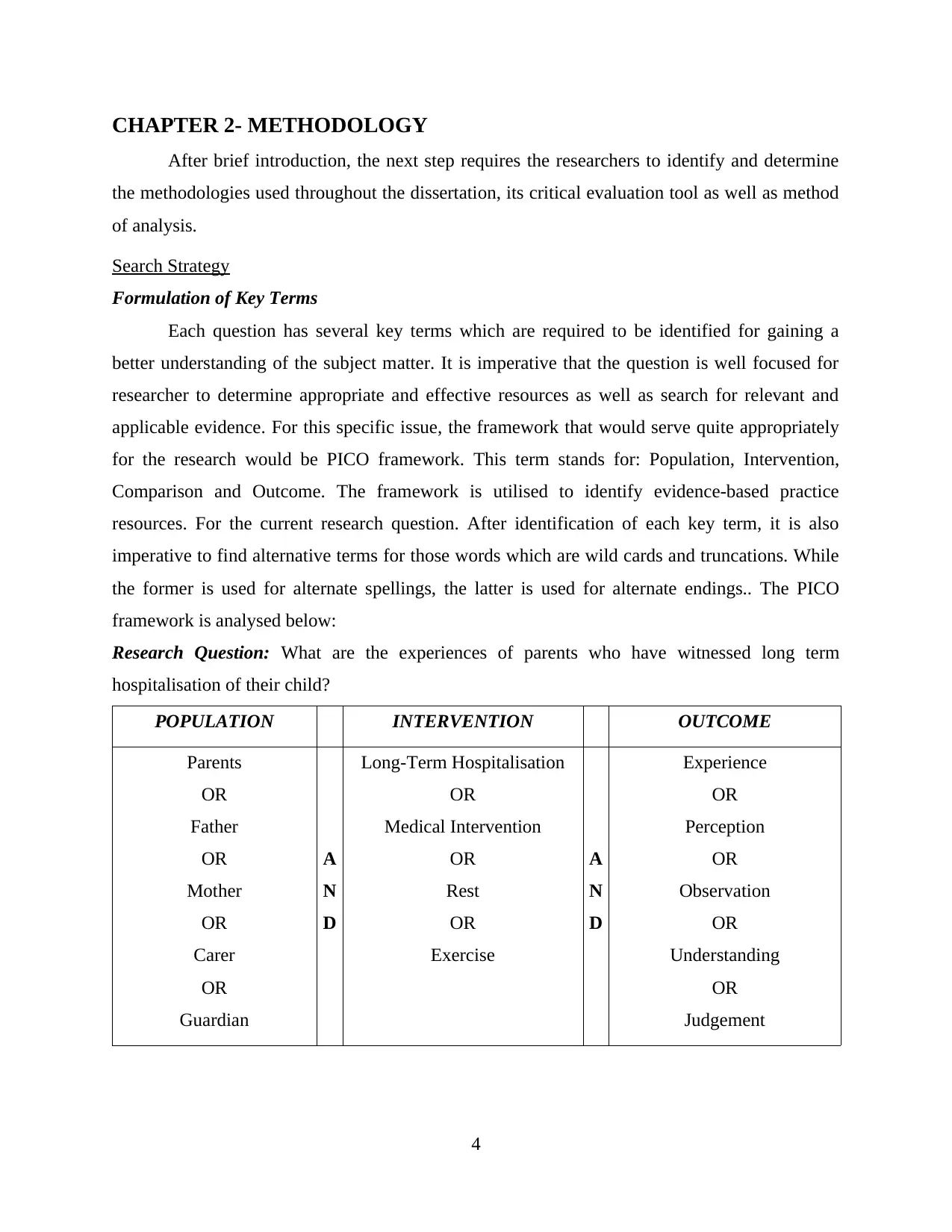
CHAPTER 2- METHODOLOGY
After brief introduction, the next step requires the researchers to identify and determine
the methodologies used throughout the dissertation, its critical evaluation tool as well as method
of analysis.
Search Strategy
Formulation of Key Terms
Each question has several key terms which are required to be identified for gaining a
better understanding of the subject matter. It is imperative that the question is well focused for
researcher to determine appropriate and effective resources as well as search for relevant and
applicable evidence. For this specific issue, the framework that would serve quite appropriately
for the research would be PICO framework. This term stands for: Population, Intervention,
Comparison and Outcome. The framework is utilised to identify evidence-based practice
resources. For the current research question. After identification of each key term, it is also
imperative to find alternative terms for those words which are wild cards and truncations. While
the former is used for alternate spellings, the latter is used for alternate endings.. The PICO
framework is analysed below:
Research Question: What are the experiences of parents who have witnessed long term
hospitalisation of their child?
POPULATION INTERVENTION OUTCOME
Parents
OR
Father
OR
Mother
OR
Carer
OR
Guardian
A
N
D
Long-Term Hospitalisation
OR
Medical Intervention
OR
Rest
OR
Exercise
A
N
D
Experience
OR
Perception
OR
Observation
OR
Understanding
OR
Judgement
4
After brief introduction, the next step requires the researchers to identify and determine
the methodologies used throughout the dissertation, its critical evaluation tool as well as method
of analysis.
Search Strategy
Formulation of Key Terms
Each question has several key terms which are required to be identified for gaining a
better understanding of the subject matter. It is imperative that the question is well focused for
researcher to determine appropriate and effective resources as well as search for relevant and
applicable evidence. For this specific issue, the framework that would serve quite appropriately
for the research would be PICO framework. This term stands for: Population, Intervention,
Comparison and Outcome. The framework is utilised to identify evidence-based practice
resources. For the current research question. After identification of each key term, it is also
imperative to find alternative terms for those words which are wild cards and truncations. While
the former is used for alternate spellings, the latter is used for alternate endings.. The PICO
framework is analysed below:
Research Question: What are the experiences of parents who have witnessed long term
hospitalisation of their child?
POPULATION INTERVENTION OUTCOME
Parents
OR
Father
OR
Mother
OR
Carer
OR
Guardian
A
N
D
Long-Term Hospitalisation
OR
Medical Intervention
OR
Rest
OR
Exercise
A
N
D
Experience
OR
Perception
OR
Observation
OR
Understanding
OR
Judgement
4
Paraphrase This Document
Need a fresh take? Get an instant paraphrase of this document with our AI Paraphraser
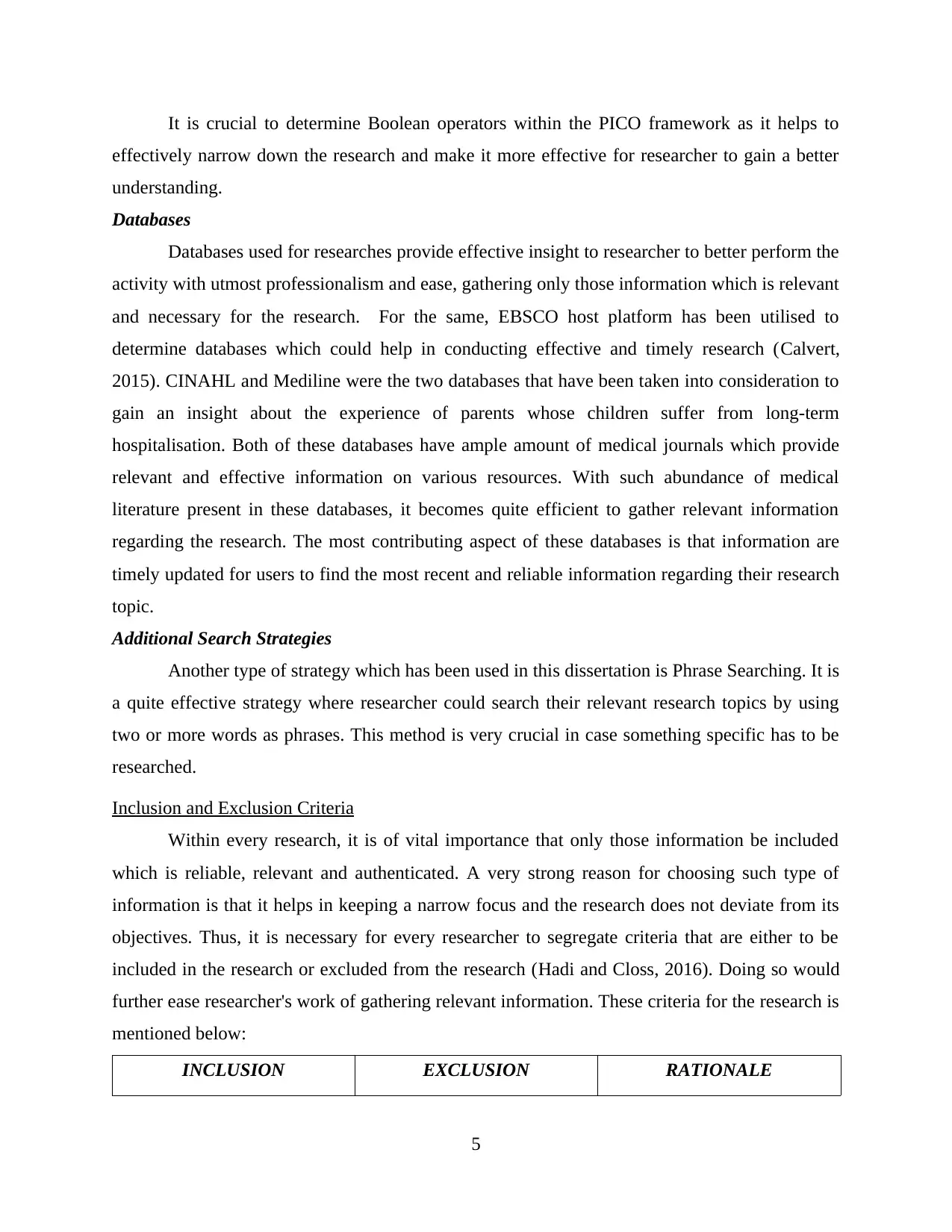
It is crucial to determine Boolean operators within the PICO framework as it helps to
effectively narrow down the research and make it more effective for researcher to gain a better
understanding.
Databases
Databases used for researches provide effective insight to researcher to better perform the
activity with utmost professionalism and ease, gathering only those information which is relevant
and necessary for the research. For the same, EBSCO host platform has been utilised to
determine databases which could help in conducting effective and timely research (Calvert,
2015). CINAHL and Mediline were the two databases that have been taken into consideration to
gain an insight about the experience of parents whose children suffer from long-term
hospitalisation. Both of these databases have ample amount of medical journals which provide
relevant and effective information on various resources. With such abundance of medical
literature present in these databases, it becomes quite efficient to gather relevant information
regarding the research. The most contributing aspect of these databases is that information are
timely updated for users to find the most recent and reliable information regarding their research
topic.
Additional Search Strategies
Another type of strategy which has been used in this dissertation is Phrase Searching. It is
a quite effective strategy where researcher could search their relevant research topics by using
two or more words as phrases. This method is very crucial in case something specific has to be
researched.
Inclusion and Exclusion Criteria
Within every research, it is of vital importance that only those information be included
which is reliable, relevant and authenticated. A very strong reason for choosing such type of
information is that it helps in keeping a narrow focus and the research does not deviate from its
objectives. Thus, it is necessary for every researcher to segregate criteria that are either to be
included in the research or excluded from the research (Hadi and Closs, 2016). Doing so would
further ease researcher's work of gathering relevant information. These criteria for the research is
mentioned below:
INCLUSION EXCLUSION RATIONALE
5
effectively narrow down the research and make it more effective for researcher to gain a better
understanding.
Databases
Databases used for researches provide effective insight to researcher to better perform the
activity with utmost professionalism and ease, gathering only those information which is relevant
and necessary for the research. For the same, EBSCO host platform has been utilised to
determine databases which could help in conducting effective and timely research (Calvert,
2015). CINAHL and Mediline were the two databases that have been taken into consideration to
gain an insight about the experience of parents whose children suffer from long-term
hospitalisation. Both of these databases have ample amount of medical journals which provide
relevant and effective information on various resources. With such abundance of medical
literature present in these databases, it becomes quite efficient to gather relevant information
regarding the research. The most contributing aspect of these databases is that information are
timely updated for users to find the most recent and reliable information regarding their research
topic.
Additional Search Strategies
Another type of strategy which has been used in this dissertation is Phrase Searching. It is
a quite effective strategy where researcher could search their relevant research topics by using
two or more words as phrases. This method is very crucial in case something specific has to be
researched.
Inclusion and Exclusion Criteria
Within every research, it is of vital importance that only those information be included
which is reliable, relevant and authenticated. A very strong reason for choosing such type of
information is that it helps in keeping a narrow focus and the research does not deviate from its
objectives. Thus, it is necessary for every researcher to segregate criteria that are either to be
included in the research or excluded from the research (Hadi and Closs, 2016). Doing so would
further ease researcher's work of gathering relevant information. These criteria for the research is
mentioned below:
INCLUSION EXCLUSION RATIONALE
5
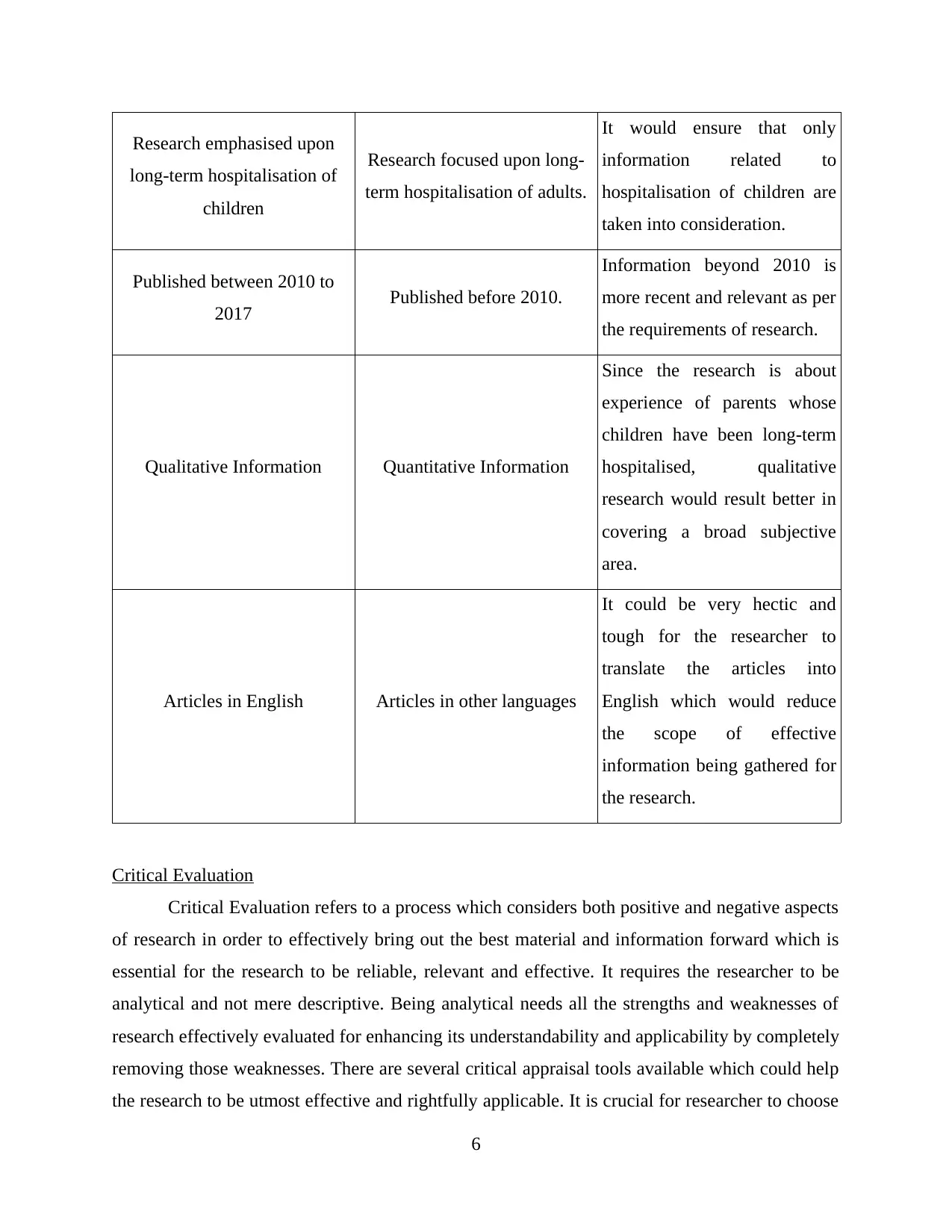
Research emphasised upon
long-term hospitalisation of
children
Research focused upon long-
term hospitalisation of adults.
It would ensure that only
information related to
hospitalisation of children are
taken into consideration.
Published between 2010 to
2017 Published before 2010.
Information beyond 2010 is
more recent and relevant as per
the requirements of research.
Qualitative Information Quantitative Information
Since the research is about
experience of parents whose
children have been long-term
hospitalised, qualitative
research would result better in
covering a broad subjective
area.
Articles in English Articles in other languages
It could be very hectic and
tough for the researcher to
translate the articles into
English which would reduce
the scope of effective
information being gathered for
the research.
Critical Evaluation
Critical Evaluation refers to a process which considers both positive and negative aspects
of research in order to effectively bring out the best material and information forward which is
essential for the research to be reliable, relevant and effective. It requires the researcher to be
analytical and not mere descriptive. Being analytical needs all the strengths and weaknesses of
research effectively evaluated for enhancing its understandability and applicability by completely
removing those weaknesses. There are several critical appraisal tools available which could help
the research to be utmost effective and rightfully applicable. It is crucial for researcher to choose
6
long-term hospitalisation of
children
Research focused upon long-
term hospitalisation of adults.
It would ensure that only
information related to
hospitalisation of children are
taken into consideration.
Published between 2010 to
2017 Published before 2010.
Information beyond 2010 is
more recent and relevant as per
the requirements of research.
Qualitative Information Quantitative Information
Since the research is about
experience of parents whose
children have been long-term
hospitalised, qualitative
research would result better in
covering a broad subjective
area.
Articles in English Articles in other languages
It could be very hectic and
tough for the researcher to
translate the articles into
English which would reduce
the scope of effective
information being gathered for
the research.
Critical Evaluation
Critical Evaluation refers to a process which considers both positive and negative aspects
of research in order to effectively bring out the best material and information forward which is
essential for the research to be reliable, relevant and effective. It requires the researcher to be
analytical and not mere descriptive. Being analytical needs all the strengths and weaknesses of
research effectively evaluated for enhancing its understandability and applicability by completely
removing those weaknesses. There are several critical appraisal tools available which could help
the research to be utmost effective and rightfully applicable. It is crucial for researcher to choose
6
⊘ This is a preview!⊘
Do you want full access?
Subscribe today to unlock all pages.

Trusted by 1+ million students worldwide
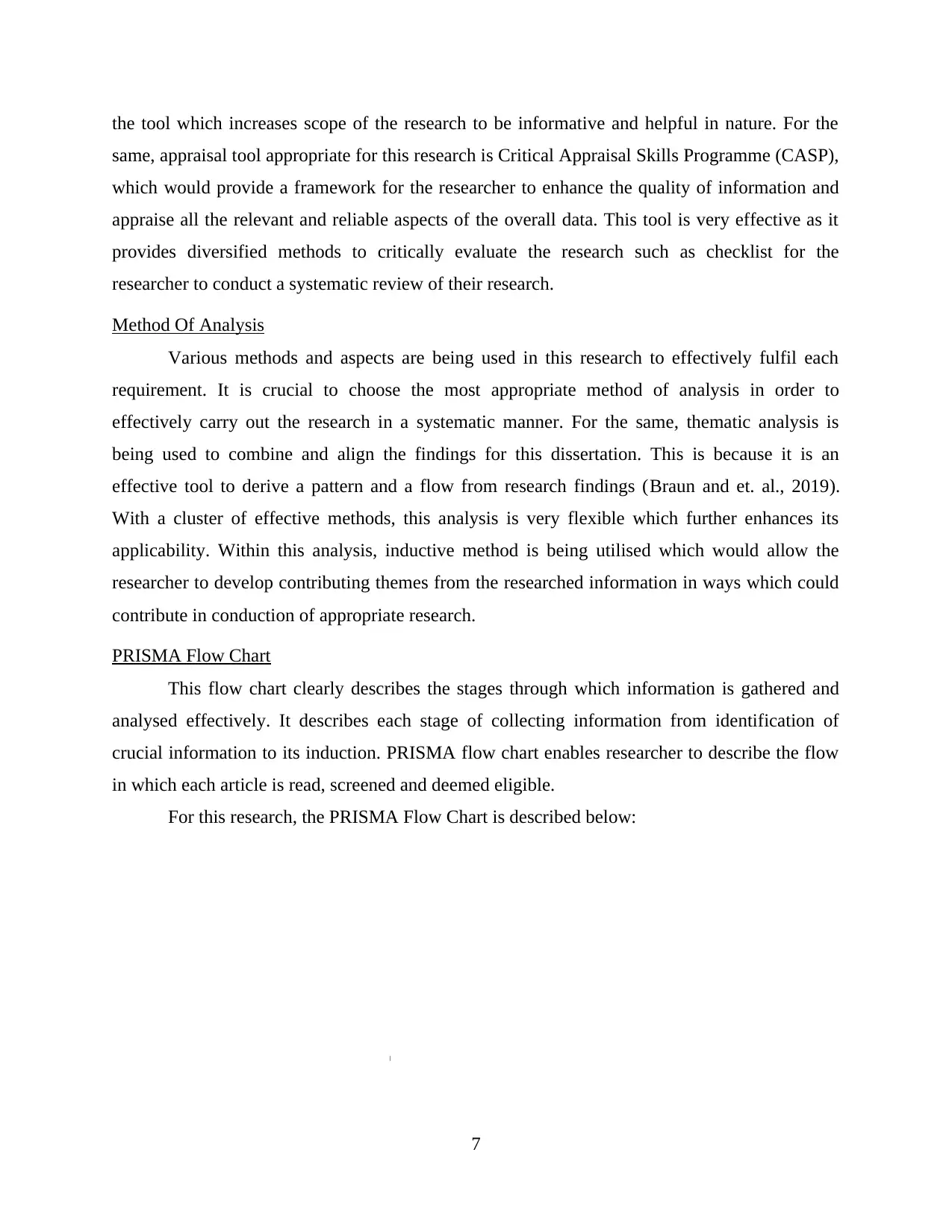
the tool which increases scope of the research to be informative and helpful in nature. For the
same, appraisal tool appropriate for this research is Critical Appraisal Skills Programme (CASP),
which would provide a framework for the researcher to enhance the quality of information and
appraise all the relevant and reliable aspects of the overall data. This tool is very effective as it
provides diversified methods to critically evaluate the research such as checklist for the
researcher to conduct a systematic review of their research.
Method Of Analysis
Various methods and aspects are being used in this research to effectively fulfil each
requirement. It is crucial to choose the most appropriate method of analysis in order to
effectively carry out the research in a systematic manner. For the same, thematic analysis is
being used to combine and align the findings for this dissertation. This is because it is an
effective tool to derive a pattern and a flow from research findings (Braun and et. al., 2019).
With a cluster of effective methods, this analysis is very flexible which further enhances its
applicability. Within this analysis, inductive method is being utilised which would allow the
researcher to develop contributing themes from the researched information in ways which could
contribute in conduction of appropriate research.
PRISMA Flow Chart
This flow chart clearly describes the stages through which information is gathered and
analysed effectively. It describes each stage of collecting information from identification of
crucial information to its induction. PRISMA flow chart enables researcher to describe the flow
in which each article is read, screened and deemed eligible.
For this research, the PRISMA Flow Chart is described below:
7
same, appraisal tool appropriate for this research is Critical Appraisal Skills Programme (CASP),
which would provide a framework for the researcher to enhance the quality of information and
appraise all the relevant and reliable aspects of the overall data. This tool is very effective as it
provides diversified methods to critically evaluate the research such as checklist for the
researcher to conduct a systematic review of their research.
Method Of Analysis
Various methods and aspects are being used in this research to effectively fulfil each
requirement. It is crucial to choose the most appropriate method of analysis in order to
effectively carry out the research in a systematic manner. For the same, thematic analysis is
being used to combine and align the findings for this dissertation. This is because it is an
effective tool to derive a pattern and a flow from research findings (Braun and et. al., 2019).
With a cluster of effective methods, this analysis is very flexible which further enhances its
applicability. Within this analysis, inductive method is being utilised which would allow the
researcher to develop contributing themes from the researched information in ways which could
contribute in conduction of appropriate research.
PRISMA Flow Chart
This flow chart clearly describes the stages through which information is gathered and
analysed effectively. It describes each stage of collecting information from identification of
crucial information to its induction. PRISMA flow chart enables researcher to describe the flow
in which each article is read, screened and deemed eligible.
For this research, the PRISMA Flow Chart is described below:
7
Paraphrase This Document
Need a fresh take? Get an instant paraphrase of this document with our AI Paraphraser
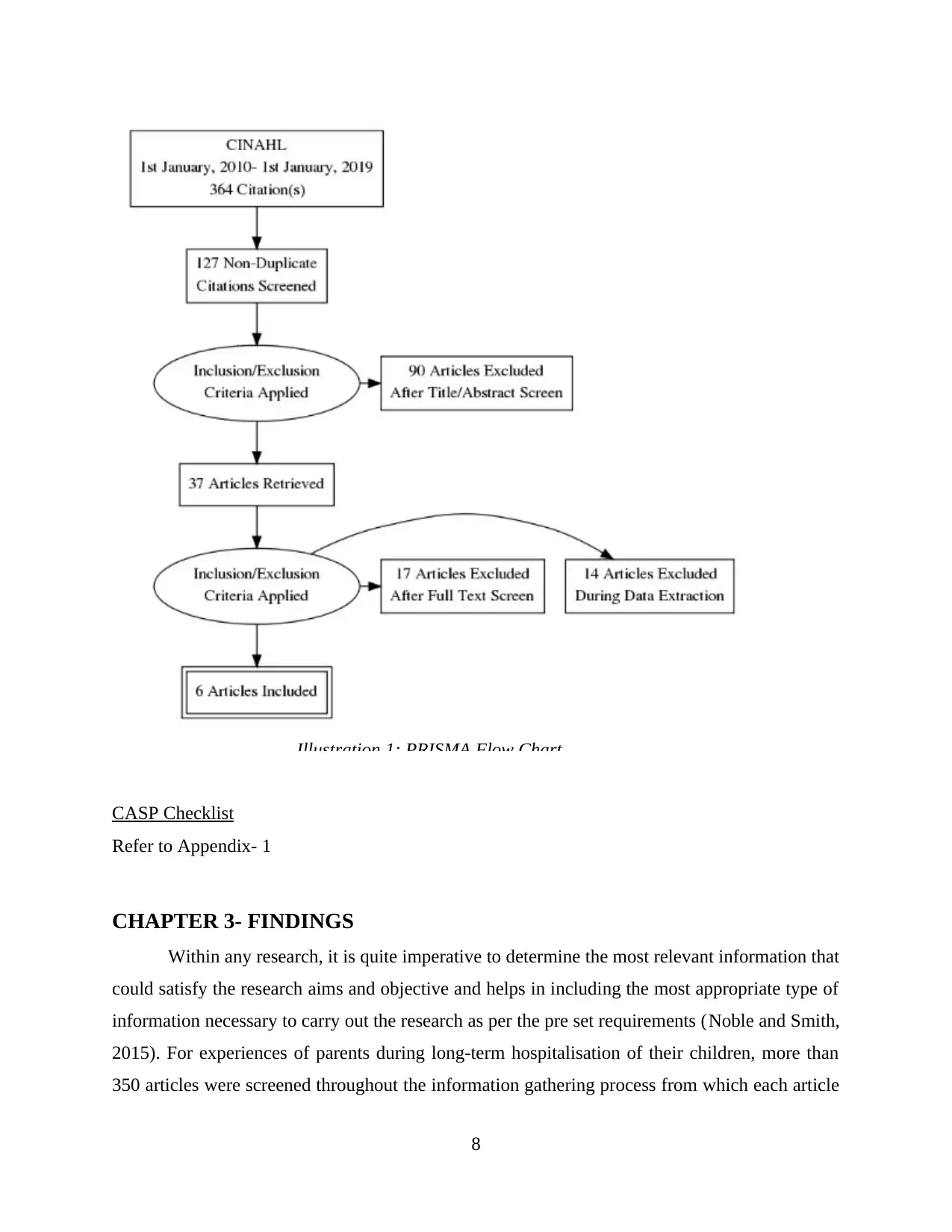
Illustration 1: PRISMA Flow Chart
CASP Checklist
Refer to Appendix- 1
CHAPTER 3- FINDINGS
Within any research, it is quite imperative to determine the most relevant information that
could satisfy the research aims and objective and helps in including the most appropriate type of
information necessary to carry out the research as per the pre set requirements (Noble and Smith,
2015). For experiences of parents during long-term hospitalisation of their children, more than
350 articles were screened throughout the information gathering process from which each article
8
CASP Checklist
Refer to Appendix- 1
CHAPTER 3- FINDINGS
Within any research, it is quite imperative to determine the most relevant information that
could satisfy the research aims and objective and helps in including the most appropriate type of
information necessary to carry out the research as per the pre set requirements (Noble and Smith,
2015). For experiences of parents during long-term hospitalisation of their children, more than
350 articles were screened throughout the information gathering process from which each article
8
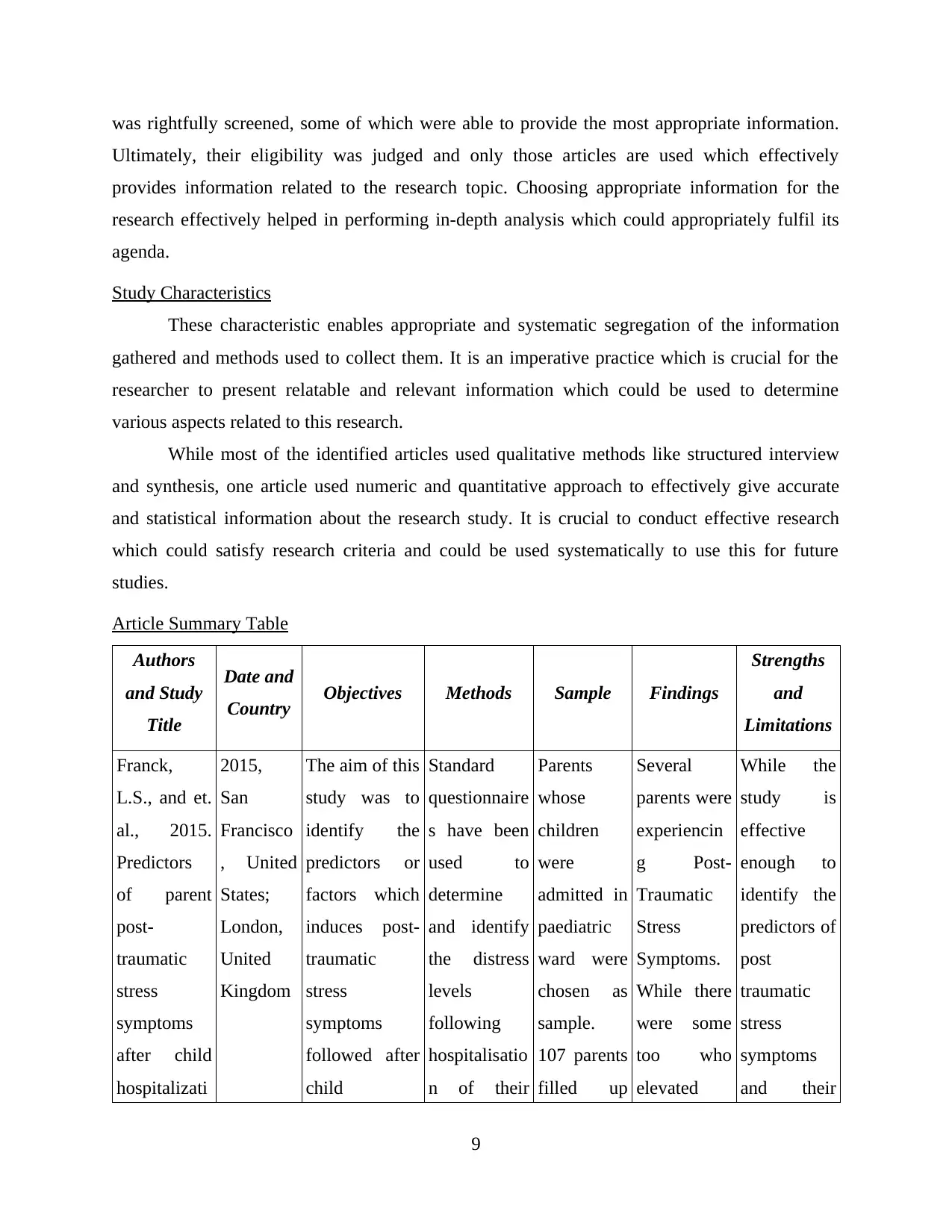
was rightfully screened, some of which were able to provide the most appropriate information.
Ultimately, their eligibility was judged and only those articles are used which effectively
provides information related to the research topic. Choosing appropriate information for the
research effectively helped in performing in-depth analysis which could appropriately fulfil its
agenda.
Study Characteristics
These characteristic enables appropriate and systematic segregation of the information
gathered and methods used to collect them. It is an imperative practice which is crucial for the
researcher to present relatable and relevant information which could be used to determine
various aspects related to this research.
While most of the identified articles used qualitative methods like structured interview
and synthesis, one article used numeric and quantitative approach to effectively give accurate
and statistical information about the research study. It is crucial to conduct effective research
which could satisfy research criteria and could be used systematically to use this for future
studies.
Article Summary Table
Authors
and Study
Title
Date and
Country Objectives Methods Sample Findings
Strengths
and
Limitations
Franck,
L.S., and et.
al., 2015.
Predictors
of parent
post-
traumatic
stress
symptoms
after child
hospitalizati
2015,
San
Francisco
, United
States;
London,
United
Kingdom
The aim of this
study was to
identify the
predictors or
factors which
induces post-
traumatic
stress
symptoms
followed after
child
Standard
questionnaire
s have been
used to
determine
and identify
the distress
levels
following
hospitalisatio
n of their
Parents
whose
children
were
admitted in
paediatric
ward were
chosen as
sample.
107 parents
filled up
Several
parents were
experiencin
g Post-
Traumatic
Stress
Symptoms.
While there
were some
too who
elevated
While the
study is
effective
enough to
identify the
predictors of
post
traumatic
stress
symptoms
and their
9
Ultimately, their eligibility was judged and only those articles are used which effectively
provides information related to the research topic. Choosing appropriate information for the
research effectively helped in performing in-depth analysis which could appropriately fulfil its
agenda.
Study Characteristics
These characteristic enables appropriate and systematic segregation of the information
gathered and methods used to collect them. It is an imperative practice which is crucial for the
researcher to present relatable and relevant information which could be used to determine
various aspects related to this research.
While most of the identified articles used qualitative methods like structured interview
and synthesis, one article used numeric and quantitative approach to effectively give accurate
and statistical information about the research study. It is crucial to conduct effective research
which could satisfy research criteria and could be used systematically to use this for future
studies.
Article Summary Table
Authors
and Study
Title
Date and
Country Objectives Methods Sample Findings
Strengths
and
Limitations
Franck,
L.S., and et.
al., 2015.
Predictors
of parent
post-
traumatic
stress
symptoms
after child
hospitalizati
2015,
San
Francisco
, United
States;
London,
United
Kingdom
The aim of this
study was to
identify the
predictors or
factors which
induces post-
traumatic
stress
symptoms
followed after
child
Standard
questionnaire
s have been
used to
determine
and identify
the distress
levels
following
hospitalisatio
n of their
Parents
whose
children
were
admitted in
paediatric
ward were
chosen as
sample.
107 parents
filled up
Several
parents were
experiencin
g Post-
Traumatic
Stress
Symptoms.
While there
were some
too who
elevated
While the
study is
effective
enough to
identify the
predictors of
post
traumatic
stress
symptoms
and their
9
⊘ This is a preview!⊘
Do you want full access?
Subscribe today to unlock all pages.

Trusted by 1+ million students worldwide
1 out of 29
Related Documents
Your All-in-One AI-Powered Toolkit for Academic Success.
+13062052269
info@desklib.com
Available 24*7 on WhatsApp / Email
![[object Object]](/_next/static/media/star-bottom.7253800d.svg)
Unlock your academic potential
Copyright © 2020–2025 A2Z Services. All Rights Reserved. Developed and managed by ZUCOL.





